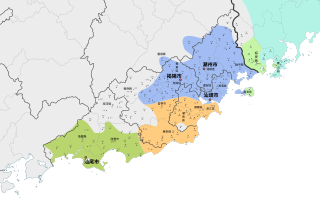

You can help expand this article with text translated from the corresponding article in Chinese. (June 2011) Click [show] for important translation instructions.
|topic= will aid in categorization.Content in this edit is translated from the existing Chinese Wikipedia article at [[:zh:海豐話]]; see its history for attribution.{{Translated|zh|海豐話}} to the talk page. |
| Hoklo | |
|---|---|
| Hailufeng, Hai Lok Hong | |
| Haklau | |
| Region | Mainly in Shanwei, eastern Guangdong province. |
Native speakers | 2.65 million (2021)[1] |
| |
Early forms | |
| Language codes | |
| ISO 639-3 | (hlh is proposed[5]) |
| ISO 639-6 | hife |
| Glottolog | None |
| Linguasphere | 79-AAA-jik (Haifeng) |

Hoklo Min in Shanwei | |
| Hoklo Min | |||||||||||||||||
|---|---|---|---|---|---|---|---|---|---|---|---|---|---|---|---|---|---|
| Traditional Chinese | 海陸豐話 | ||||||||||||||||
| Simplified Chinese | 海陆丰话 | ||||||||||||||||
| |||||||||||||||||
Hoklo, Hailufeng (海陸丰 Hai Lok Hong), or in the language itself Haklau, is a variety of Chinese mostly spoken in the Hailufeng region of Guangdong. The region includes Shanwei (Swabue), which administratively includes Haifeng County (海丰 Hai Hong), and Lufeng City (陸丰 Lok Hong), which itself was a former county and now county-level city. The name 'Hailufeng' / 'Hai Lok Hong' (海陸丰) is a portmanteau of those places. It is a Southern Min (Min Nan) language with similarities to Hokkien, especially Chiangchew Hokkien, though it also has close geographical and cultural ties with neighboring Teo-Swa.[6][7] Ethnically, the Hoklo see themselves as Hailok, separate from the Teochews.
Differences from Teochew dialect proper include the preservation of the final codas -t and -n, which are completely lost in Teochew, as well as the absence of the -oi finals.
|
Sino-Tibetan branches
| |||||
|---|---|---|---|---|---|
| Western Himalayas (Himachal, Uttarakhand, Nepal, Sikkim) |
| ||||
| Eastern Himalayas (Tibet, Bhutan, Arunachal) |
| ||||
| Myanmar and Indo-Burmese border |
| ||||
| East and Southeast Asia |
| ||||
| Dubious (possible isolates) (Arunachal) |
| ||||
| Proposed groupings |
| ||||
| Proto-languages |
| ||||
Italics indicates single languages that are also considered to be separate branches. | |||||
|
| ||||||||||||||||||||||||||||||||||
|---|---|---|---|---|---|---|---|---|---|---|---|---|---|---|---|---|---|---|---|---|---|---|---|---|---|---|---|---|---|---|---|---|---|---|
| ||||||||||||||||||||||||||||||||||
| ||||||||||||||||||||||||||||||||||
| ||||||||||||||||||||||||||||||||||
|
| |||||||||||||||||||||||||||||||||||||||||||||||||||||||||||||||||||||
|---|---|---|---|---|---|---|---|---|---|---|---|---|---|---|---|---|---|---|---|---|---|---|---|---|---|---|---|---|---|---|---|---|---|---|---|---|---|---|---|---|---|---|---|---|---|---|---|---|---|---|---|---|---|---|---|---|---|---|---|---|---|---|---|---|---|---|---|---|---|
| Major groups |
| ||||||||||||||||||||||||||||||||||||||||||||||||||||||||||||||||||||
| Standard forms |
| ||||||||||||||||||||||||||||||||||||||||||||||||||||||||||||||||||||
| Phonology |
| ||||||||||||||||||||||||||||||||||||||||||||||||||||||||||||||||||||
| Grammar |
| ||||||||||||||||||||||||||||||||||||||||||||||||||||||||||||||||||||
| Idioms |
| ||||||||||||||||||||||||||||||||||||||||||||||||||||||||||||||||||||
| Input |
| ||||||||||||||||||||||||||||||||||||||||||||||||||||||||||||||||||||
| History |
| ||||||||||||||||||||||||||||||||||||||||||||||||||||||||||||||||||||
| Literary forms |
| ||||||||||||||||||||||||||||||||||||||||||||||||||||||||||||||||||||
| Scripts |
| ||||||||||||||||||||||||||||||||||||||||||||||||||||||||||||||||||||